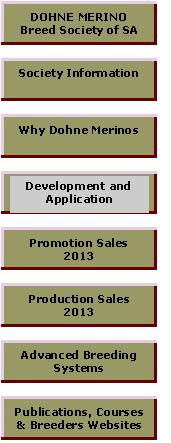

|
Development and application of Dual-Purpose Merino types i.e. Dohne Merino
The current economic climate requires a low-input animal capable of generating maximum income under extensive conditions at the lowest possible cost. In order to meet this requirement wool and meat should be produced in an optimum relationship to each other within environmental constraints. Because a large part of the pastoral zone of the RSA comprises coarse indigenous pasture of low nutritional value, known as sourveld, there has been a need for the development of breeds better adapted to these regions. Under these circumstances traditional woolled sheep have under-performed in terms of meat production and have yielded sub-marginal profits. To increase total flock income many woolgrowers have resorted to dual-purpose breeds that combine fine wool production, higher fertility and slaughter lamb production in wool/meat production systems. The rate at which the shift from conventional woolled sheep to dual-purpose breeds has taken place, has varied from one region to another. In the Southern Cape for example, dual-purpose sheep trebled in number between 1986 and 1991 (Agricultural News 28/9/92). A number of dual-purpose breeds emerged in the last seven decades e.g. Letelle, Walrich, Dohne Merino, SA Mutton Merino. As a result of similar phenotypes, the Dohne Merino and Walrich merged in 1982.
Advantages that flow from the versatility of the Dohne Merino
* The low cost features like hardiness, adaptability and less selective grazing habits minimize management and production costs. * High fertility and rapid lamb growth rates enable large numbers of lambs to be produced and marketed before the onset of the next lambing season. This increases the income from the meat component relative to that of wool, which improves the net income of sheep flocks. * Relatively heavy carcasses with a low fat distribution and excellent grades are produced. * The excellent feed conversion of the Dohne Merino provides the options to finish lambs on good pastures or in feedlots. * The production of merino wool means the continuation of a tradition, the preservation of a culture and gives stability to the economy of woolled sheep farming.
Advantages of Dohne Merinos in the winter rainfall regions
Dohnes can be more easily maintained through the summer on low quality roughage, consequently stocking rates can even be increased. Rapid growth rates enable surplus animals to be marketed before the onset of summer. The high fertility of the breed is properly exploited by an autumn mating, making winter lambing viable. The hardy Dohne lamb is able to survive the cold. |
|
Summary
The changes in the long-term price trends of wool and meat necessitate a sound understanding of the factors that influence the profitability of woolled sheep breeding. These changes have brought new challenges and opportunities for the woolled sheep farmer. However, to fully exploit the potential of current market trends a radical departure from traditional breeding objectives and production systems is required. The highly versatile Dohne Merino will enable astute sheep breeders to take advantage of changing economic circumstances and ensure a bright and profitable future. Since selection objectives and selection indices are more accurately determined according to long term price movements and market trends, the prices over the four decades 1960 to 2000, were used for the observations in the above article. Both wool and meat prices improved significantly during 2001 and 2002, as a result of which the price ratios between the two commodities have changed. Market analysts maintain that the dramatic increases in wool prices this year have not been consumer driven, but should be attributed to other factors. Consequently it is unlikely that the current prices will be sustained and that wool prices will stabilize at slightly lower levels in the medium term. On the other hand, it appears that meat price rises are the result of higher consumer demand, short supply and higher grain prices and consequently should remain at these levels. The degree to which production systems and selection objectives will react to current changes in the price of wool and meat will become clear in the next five to ten years. |

|
Contact information: e-mail: manager@dohnemerino.co.za Web: www.dohnemerino.org |

|
Developed by Hazeldean Computers e-mail: stewart@hazeldean.co.za Web: www.hazeldean.co.za |
